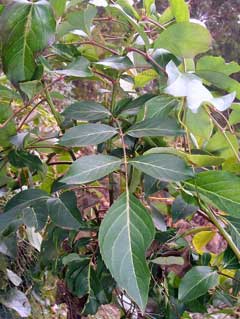 |
|
/www.flickr.com/photos/22616984@N07 |
 |
|
Translate this page:
Summary
Physical Characteristics

 Polyscias sambucifolia is an evergreen Shrub growing to 4.5 m (14ft 9in) at a medium rate.
Polyscias sambucifolia is an evergreen Shrub growing to 4.5 m (14ft 9in) at a medium rate.
See above for USDA hardiness. It is hardy to UK zone 9. It is in leaf all year, in flower from May to June. The species is hermaphrodite (has both male and female organs).
Suitable for: light (sandy), medium (loamy) and heavy (clay) soils. Suitable pH: mildly acid, neutral and basic (mildly alkaline) soils. It can grow in semi-shade (light woodland) or no shade. It prefers moist soil. The plant can tolerates strong winds but not maritime exposure.
UK Hardiness Map
US Hardiness Map
Synonyms
Panax sambucifolium. Nothopanax sambucifolium. Tieghemopanax sambucifolius
Plant Habitats
Woodland Garden Sunny Edge; Dappled Shade; Hedge;
Edible Uses
Edible Parts:
Edible Uses: Gum
None known
References More on Edible Uses
Medicinal Uses
Plants For A Future can not take any responsibility for any adverse effects from the use of plants. Always seek advice from a professional before using a plant medicinally.
None known
References More on Medicinal Uses
The Bookshop: Edible Plant Books
Our Latest books on Perennial Plants For Food Forests and Permaculture Gardens in paperback or digital formats.

Edible Tropical Plants
Food Forest Plants for Hotter Conditions: 250+ Plants For Tropical Food Forests & Permaculture Gardens.
More

Edible Temperate Plants
Plants for Your Food Forest: 500 Plants for Temperate Food Forests & Permaculture Gardens.
More

More Books
PFAF have eight books available in paperback and digital formats. Browse the shop for more information.
Shop Now
Other Uses
Gum Hedge Hedge Wood
Fairly fast growing and tolerant of shearing, this species can be grown as a hedge[200]. A gum similar to 'gum arabic' (which is obtained from various Acacia species) is obtained from this plant[64]. It is not wholly soluble[64]. Wood - too soft and perishable to be of economic value[154].
Special Uses
Hedge Hedge
References More on Other Uses
Cultivation details
Prefers a deep rich moist soil[1]. This species is not very hardy in Britain, though it can succeed outdoors in the milder areas of the country[1, 11]. It tolerates temperatures down to about -7°c in Australian gardens[157], though this cannot be translated directly to British gardens due to our cooler summers and longer, colder and wetter winters. A very ornamental plant[1]. The leaves are very variable[200]. A very variable species, closer investigation will probably reveal that it is comprised of a number of different species[265]. Some forms of this species produce suckers[157]. The plant has good wind-resistance[200].
References Carbon Farming Information and Carbon Sequestration Information
Temperature Converter
Type a value in the Celsius field to convert the value to Fahrenheit:
Fahrenheit:
The PFAF Bookshop
Plants For A Future have a number of books available in paperback and digital form. Book titles include Edible Plants, Edible Perennials, Edible Trees,Edible Shrubs, Woodland Gardening, and Temperate Food Forest Plants. Our new book is Food Forest Plants For Hotter Conditions (Tropical and Sub-Tropical).
Shop Now
Plant Propagation
Seed - sow spring in a greenhouse. When they are large enough to handle, prick the seedlings out into individual pots and grow them on in the greenhouse for at least their first winter. Plant them out into their permanent positions in late spring or early summer, after the last expected frosts. Consider giving the plants some protection from the cold for at least their first winter outdoors. Softwood cuttings in early summer root easily in a closed case[200]. Leafless stem cuttings in the summer root easily in a closed case[200].
Other Names
If available other names are mentioned here
Native Range
AUSTRALASIA: Australia (Tasmania, New South Wales (east), Queensland (southeast), Victoria (east & south))
Weed Potential
Right plant wrong place. We are currently updating this section.
Please note that a plant may be invasive in one area but may not in your area so it's worth checking.
Conservation Status
IUCN Red List of Threatened Plants Status :

Growth: S = slow M = medium F = fast. Soil: L = light (sandy) M = medium H = heavy (clay). pH: A = acid N = neutral B = basic (alkaline). Shade: F = full shade S = semi-shade N = no shade. Moisture: D = dry M = Moist We = wet Wa = water.
Now available:
Food Forest Plants for Mediterranean Conditions
350+ Perennial Plants For Mediterranean and Drier Food Forests and Permaculture Gardens.
[Paperback and eBook]
This is the third in Plants For A Future's series of plant guides for food forests tailored to
specific climate zones. Following volumes on temperate and tropical ecosystems, this book focuses
on species suited to Mediterranean conditions—regions with hot, dry summers and cool, wet winters,
often facing the added challenge of climate change.
Read More
Expert comment
Author
(Sieber. ex Dc.)Harms.
Botanical References
11200265
Links / References
For a list of references used on this page please go here
Readers comment
© 2010, Plants For A Future. Plants For A Future is a charitable company limited by guarantee, registered in England and Wales. Charity No. 1057719, Company No. 3204567.